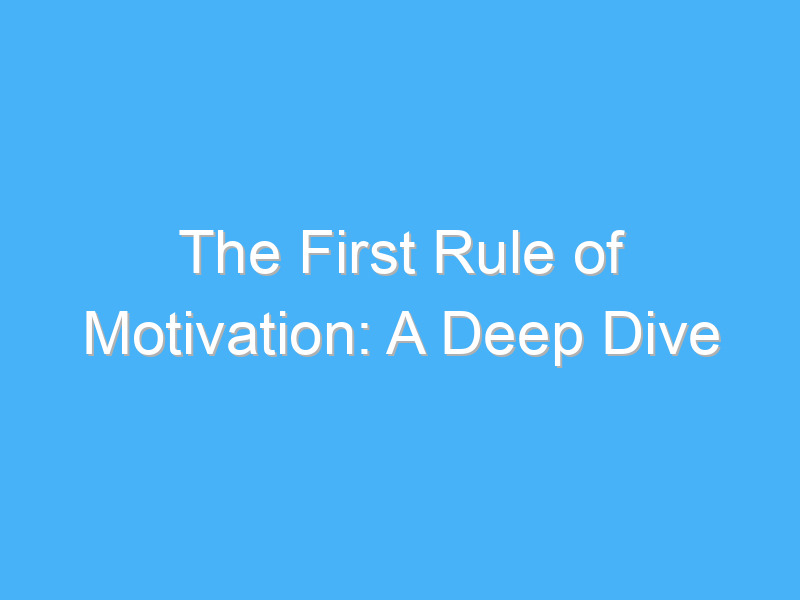
The First Rule of Motivation: A Deep Dive
Motivation is a crucial factor in achieving success, whether it be in personal or professional settings. However, the first rule of motivation is often overlooked or forgotten. In this discussion, we will be exploring what the first rule of motivation is and its importance in achieving our goals.
Understanding Motivation
Motivation is the driving force behind every action we take. It’s what gets us out of bed in the morning and what keeps us going during difficult times. Motivation is what propels us towards our goals, and without it, we would be stagnant.
Misconceptions about Motivation
There are many misconceptions about motivation. Some people believe that motivation is something that you either have or don’t have. Others believe that motivation is something that comes from external sources, such as rewards or punishments. However, motivation is much more complex than that.
Internal vs. External Motivation
There are two types of motivation: internal and external. Internal motivation comes from within and is driven by personal desires and goals. External motivation, on the other hand, comes from outside sources, such as rewards, recognition, or pressure from others.
Intrinsic vs. Extrinsic Motivation
Similarly, there are two types of external motivation: intrinsic and extrinsic. Intrinsic motivation is driven by a personal desire to succeed or achieve something, while extrinsic motivation is driven by external rewards or consequences.
The Role of Emotion in Motivation
Emotions play a crucial role in motivation. Positive emotions, such as happiness and excitement, can fuel motivation, while negative emotions, such as fear and anxiety, can hinder it. It’s important to understand your emotional state and how it affects your motivation levels.
The First Rule of Motivation
So, what is the first rule of motivation? The answer is simple: there is no one-size-fits-all rule. Motivation is a complex and personal concept that varies from person to person. However, there are some general guidelines that can help boost motivation levels.
Set Realistic Goals
One of the most important factors in motivation is setting realistic goals. Goals that are too lofty or unattainable can be demotivating, while goals that are too easy can be uninspiring. It’s important to find the right balance and set goals that are challenging but achievable.
Find Your Why
Another crucial factor in motivation is understanding your why. Why do you want to achieve your goals? What drives you? By understanding your why, you can tap into your intrinsic motivation and stay focused on your goals.
Create a Plan
Once you have set realistic goals and understand your why, it’s important to create a plan. A plan can help you stay organized and focused on the steps you need to take to achieve your goals.
Celebrate Small Wins
Celebrating small wins along the way can also help boost motivation levels. By acknowledging your progress and accomplishments, you can stay motivated and inspired to keep going.
Surround Yourself with Support
Finally, it’s important to surround yourself with support. Whether it’s friends, family, or a mentor, having a support system can help keep you motivated and accountable.
FAQs – What is the first rule of motivation?
What is motivation?
Motivation is the driving force that compels us towards achieving our goals. It is an intrinsic or extrinsic factor that influences our behavior, thoughts, and emotions to pursue a particular objective.
What is the first rule of motivation?
The first rule of motivation is to have a clear and specific goal. Without a goal, there is no motivation. You need to have a purpose that is meaningful enough to drive you towards working hard and sticking to your plan. Therefore, it is essential to identify what you want to achieve, break it down into small actionable steps, and prioritize your efforts towards achieving the goal.
How can I stay motivated?
There are several ways to stay motivated. One of the most effective ways is to keep your goals in mind continuously. You can write down your goals, put them on a vision board, or use them as a screensaver to remind yourself of what you want to achieve. Additionally, you can find a support system such as a mentor or accountability partner to keep you on track and provide encouragement. Celebrating small victories and progress towards your goals can also help fuel your motivation.
What are some common barriers to motivation?
Some common barriers to motivation include fear of failure, lack of confidence, feeling overwhelmed, and distractions. These barriers can make it difficult to stay focused and motivated. To overcome these barriers, you need to break down your goals into small and manageable steps, find inspiration from successful individuals who have achieved similar objectives, and develop a positive mindset by focusing on your strengths and learning from your mistakes.
Can motivation be learned?
Yes, motivation can be learned. Like any skill, it takes practice, effort, and self-awareness. You can learn effective strategies to stay motivated, such as goal-setting, positive self-talk, and visualization. Additionally, seeking out resources such as books, videos, and courses on motivation can help you develop the mindset and habits necessary to stay motivated and committed to your goals.
